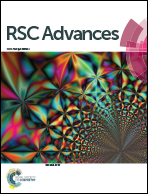Improved electrochemical performance of LiNi0.8Co0.15Al0.05O2 with ultrathin and thickness-controlled TiO2 shell via atomic layer deposition technology
Abstract
Atomic layer deposition (ALD) technology is used to deposit TiO2 coating on the nickel-rich material LiNi0.8Co0.15Al0.05O2. The ultrathin and thickness-controlled coating shell serves as a physical barrier which protects the structure of the core and thereby enhances the electrochemical performance of the coated material. Coating shells of TiO2 with different thicknesses corresponding to different ALD cycles are obtained and detected via transmission electron microscope (TEM) analysis. A TiO2-coated sample with 138 ALD cycles reveals optimal electrochemical performance in the voltage range of 2.8–4.5 V. After 100 cycles, discharge capacities of 171.36 and 154.69 mA h g−1 at room (25 °C) and elevated (55 °C) temperatures are observed, with higher cycle-ability of 90.21% and 73.21%, in comparison with those of 50.13% and 43.97% for pristine samples at the same temperatures. The improvements in electrochemical characterizations are ascribed to the stable structure and interface modified by the high-quality dense, ultrathin and amorphous ALD TiO2 coating layer, which can protect the cathode particles from hydrofluoric acid attack.


 Please wait while we load your content...
Please wait while we load your content...